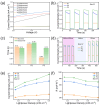Enhancing the Performance of Si/Ga2O3 Heterojunction Solar-Blind Photodetectors for Underwater Applications
- PMID: 40711256
- PMCID: PMC12300985
- DOI: 10.3390/nano15141137
Enhancing the Performance of Si/Ga2O3 Heterojunction Solar-Blind Photodetectors for Underwater Applications
Abstract
Epitaxial growth of β-Ga2O3 nanowires on silicon substrates was realized by the low-pressure chemical vapor deposition (LPCVD) method. The as-grown Si/Ga2O3 heterojunctions were employed in the Underwater DUV detection. It is found that the carrier type as well as the carrier concentration of the silicon substrate significantly affect the performance of the Si/Ga2O3 heterojunction. The p-Si/β-Ga2O3 (2.68 × 1015 cm-3) devices exhibit a responsivity of up to 205.1 mA/W, which is twice the performance of the devices on the n-type substrate (responsivity of 93.69 mA/W). Moreover, the devices' performance is enhanced with the increase in the carrier concentration of the p-type silicon substrates; the corresponding device on the high carrier concentration substrate (6.48 × 1017 cm-3) achieves a superior responsivity of 845.3 mA/W. The performance enhancement is mainly attributed to the built-in electric field at the p-Si/n-Ga2O3 heterojunction and the reduction in the Schottky barrier under high carrier concentration. These findings would provide a strategy for optimizing carrier transport and interface engineering in solar-blind UV photodetectors, advancing the practical use of high-performance solar-blind photodetectors for underwater application.
Keywords: Ga2O3 nanostructures; photodetector; self-power; solar-blind ultraviolet.
Conflict of interest statement
The authors declare that they have no known competing financial interests or personal relationships that could have appeared to influence the work reported in this paper.
Figures






References
-
- Xu J., Zheng W., Huang F. Gallium oxide solar-blind ultraviolet photodetectors: A review. J. Mater. Chem. C. 2019;7:8753–8770. doi: 10.1039/C9TC02055A. - DOI
-
- Qin Y., Long S., Dong H., He Q., Jian G., Zhang Y., Hou X., Tan P., Zhang Z., Lv H., et al. Review of deep ultraviolet photodetector based on gallium oxide. Chin. Phys. B. 2019;28:018501. doi: 10.1088/1674-1056/28/1/018501. - DOI
-
- Luo Y., Wang D., Kang Y., Liu X., Fang S., Memon M.H., Yu H., Zhang H., Luo D., Sun X., et al. Demonstration of Photoelectrochemical-Type Photodetectors Using Seawater as Electrolyte for Portable and Wireless Optical Communication. Adv. Opt. Mater. 2022;10:2102839. doi: 10.1002/adom.202102839. - DOI
Grants and funding
LinkOut - more resources
Full Text Sources

